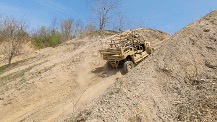Vehicle Controls & Behaviors
Annual PlanResilient Trajectory Planning for Extreme Mobility on Challenging Slopes
Project Team
Government
Paramsothy Jayakumar, US Army GVSC
Industry
Chenyu Yi, Mercedes-Benz
Andrew Kwas, Northrop-Grumman
Student
James Baxter, U. of Michigan
Project Summary
Project begins 2023.
This project aims for resilient off-road mobility on 3D terrains by enabling extreme maneuvers for autonomous ground vehicles on challenging off-road slopes, including detecting and learning from failures and transferring learning from one slope to other similar ones. The context of interest is slopes with large steepness, soft soils, and irregular topology that require a complex coordination of speed and steering for a purposeful exploitation of vehicle dynamics to navigate successfully. The large magnitude of these slopes and the characteristics of the soils make the terrain impossible to navigate without such extreme coordinated maneuvers. Such navigation is challenging even for human drivers, and may require learning from multiple failed attempts.

The proposed research seeks a new resilient local trajectory planning solution for extreme mobility on slopes. The focus is on three fundamental research questions:
(RQ1) How can a local trajectory planning algorithm provide safe extreme solutions for autonomous vehicles with significant dynamics on challenging slopes (uneven, steep, with complex soils) in real time, even when the details of the vehicle and environment are estimated probabilistically and not fully known? Here, a safe solution is one that avoids fatal failures but allows the possibility of non-fatal ones.
(RQ2) How can the noisy data collected by the vehicle through proprioceptive means be used to refine the vehicle’s understanding of the terramechanics to enhance its mobility?
(RQ3) When the vehicle makes a non-fatal failed attempt to navigate a complex terrain, how can the vehicle recognize the failure and make a new attempt that leverages knowledge of past failures, and how can knowledge gained on one slope be applied to subsequent slopes?
#1.41

